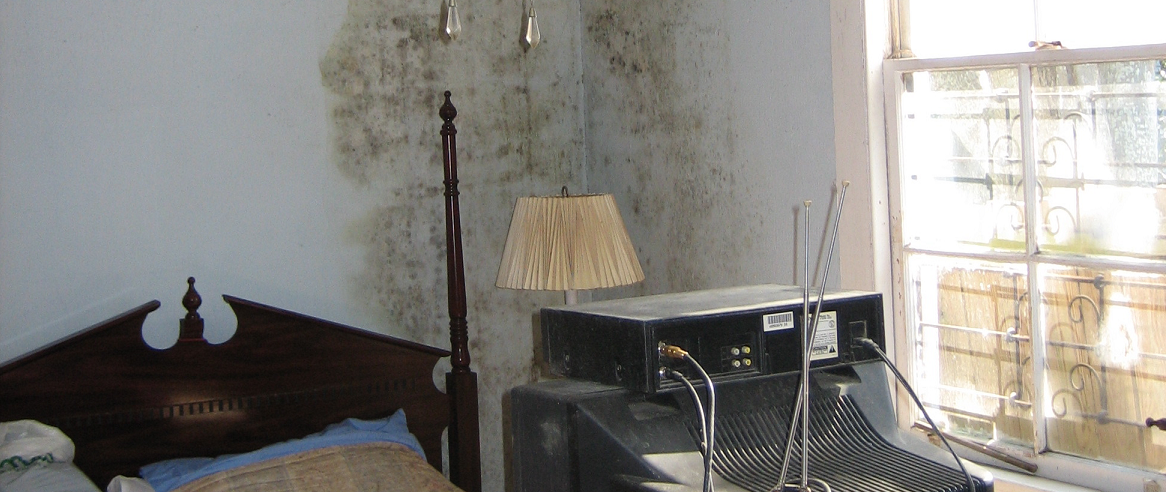Why Mold and Health Go Hand in Hand
Is there a musty smell in your home driving you crazy, especially because it’s making you feel unwell? It could be mold. If that’s the case, it’s understandable to wonder “how do I know if mold is making me sick?” While mold is a natural part of the environment, it becomes a danger to your health when it grows indoors.
Spores spread easily through air currents, attaching to clothes, shoes, and pets. Once inside, they thrive anywhere moisture collects, from bathroom tiles to basement walls. Over time, this exposure can lead to health problems ranging from mild allergic reactions to long-term respiratory disease.
Short-term symptoms are often mistaken for allergies or colds. But research shows mold exposure can worsen asthma, cause lung infections in vulnerable individuals, and even contribute to mental health challenges. That’s why consulting a mold specialist or mold remediation expert is critical when illness persists without clear cause. For a deeper look at the dangers of hidden mold, see Mold and Your Health: What You Need to Know.
What Really Happens When You Breathe in Mold at Home
Molds produce allergens and irritants, and certain species release mycotoxins that can be harmful if inhaled or ingested. When spores land on damp surfaces, they multiply quickly, and repeated exposure makes the body more likely to react.
Indoor mold exposure can cause coughing, wheezing, and asthma attacks even in people who were healthy before. These aren’t just minor irritations. They can lead to chronic conditions that disrupt daily life.
Studies have also identified a connection between mold exposure in childhood and the later development of asthma. This takes mold from a short-term nuisance to a risk factor for long-term respiratory disease. In particular, children, the elderly, and those with genetic predispositions are most at risk.
Warning Signs and Symptoms of Mold-Related Illness
Mold illness often hides behind symptoms that look like common colds or seasonal allergies. But the range of possible effects is much broader than most people realize.
Allergy-Like Reactions You Shouldn’t Ignore
Allergic symptoms are the most widely reported. Mold exposure can trigger sneezing, a constantly runny nose, and nasal congestion that doesn’t respond to antihistamines. Red or watery eyes and skin rashes are also common signs that the body is reacting to airborne spores.
These reactions may occur right away or several hours after exposure. This delayed pattern can make it harder to connect symptoms directly to mold. People often live with recurring illness without realizing the source is their environment.
Breathing Problems Linked to Mold Exposure
Mold exposure places extra stress on the respiratory system. Persistent coughing, sore throats, and wheezing are common complaints. For those with asthma, contact with mold spores can immediately trigger an attack, often more severe than reactions to pollen or dust.
Children are especially vulnerable. One study found infants in moldy homes were three times more likely to develop asthma by age seven. In some cases, species like Aspergillus fumigatus cause “fungal asthma,” where excess mucus clogs the airways, making breathing extremely difficult. Seasonal challenges can also play a role — winter is a riskier season for asthma sufferers, adding another layer of concern.
Cognitive and Neurological Red Flags
Less obvious but even more concerning are the cognitive effects. People living in moldy environments have reported memory loss, dizziness, blurred vision, and tinnitus. These problems may stem from the inflammatory response triggered by long-term exposure to spores and toxins.
Brain fog and reduced concentration are also frequently reported. School and work performance suffer in the wake of these issues. But, they’re often misdiagnosed as stress-related instead of due to environmental conditions.
How Mold Affects Your Mental Health
Beyond physical illness, mold has been linked to psychological distress. Studies show higher rates of depression, anxiety, and chronic stress among adults and children exposed to damp, moldy housing. Living in a persistently unhealthy environment can impact mood and quality of life.
The connection between environmental stressors and mental health is complex. Yet, there is consensus between experts that mold exposure fuels a cycle of physical and emotional strain. Addressing the root cause through a professional mold removal service can sharpen your physical and mental health.
Long-Term Health Risks from Household Mold
For those with weakened immune systems or chronic lung disease, mold exposure can be life-threatening. These individuals are at risk of fungal lung infections that need immediate medical care and often prolonged treatment.
Long-term exposure to certain molds can also alter immune system function. Some molds produce aflatoxins, which have been classified as human carcinogens and are linked to liver cancer. Others can produce mycotoxins, which are uncommon in households. Their presence highlights the urgency of dealing with mold growth ASAP.
Long-term mold exposure may also cause memory problems, mood changes, and immune disruption. Children and immune-compromised individuals face the greatest risks, underscoring the importance of calling a mold specialist or licensed mold contractor when mold growth is suspected. Learn more about black mold specifically in How Black Mold Affects Your Health and Why You Need Mold Testing in NYC.
Who Is Most at Risk from Mold in the Home?
Not everyone responds to mold in the same way. Some individuals may show no symptoms, while others experience severe illness. Understanding who is most vulnerable helps in recognizing when professional intervention is urgent.
| Group | Why They’re at Higher Risk | Evidence |
| Infants & Children | Developing immune systems; greater indoor exposure | Babies in moldy homes were three times more likely to develop asthma by age seven. Children exposed at school had significantly more asthma symptom days. |
| Asthma & Allergy Patients | Mold triggers flare-ups | Mold exposure is a common cause of asthma attacks in those already sensitized. |
| Elderly | Natural immune decline with age | Severity of illness depends heavily on individual health status. |
| Immunocompromised | Poor ability to fight infection | Mold-related lung infections are more common in people with weakened immune systems. |
| Workers in High-Risk Jobs | Frequent occupational exposure | Farmers exposed to moldy hay often develop fever and respiratory distress. |
Caregivers should also be aware — home caregivers play an important role in spotting mold exposure in seniors.
How to Tell If Mold — Not a Cold — Is Making You Sick
Because mold illness mimics common conditions, it helps to recognize environmental patterns. A few signs can help distinguish mold-related sickness from seasonal or viral problems.
- Your symptoms worsen indoors but improve when you leave. If relief comes after a few hours away from home, mold is a strong suspect.
- Asthma or allergies worsen unexpectedly. Mold can trigger attacks even when pollen counts are low.
- Many people in the same building are sick. Shared illness suggests an environmental source rather than a contagious virus.
- Your home shows visible or hidden signs of dampness. Musty odors, water stains, or peeling wallpaper often point to mold growth.
- You notice unusual neurological or mood symptoms. Dizziness, memory issues, or depression may signal chronic exposure.
Mold illness often looks like allergies — sneezing, runny nose, itchy eyes, coughing, or rash. If symptoms improve when you leave home but return indoors, or affect many family members, mold exposure is likely. In these cases, a mold inspection specialist should be contacted.
The Overlooked Mental and Cognitive Effects of Mold
Mold’s impact on mental and cognitive health can’t be overlooked. Short-term neurological issues include dizziness, blurred vision, and lightheadedness. Over time, memory loss and difficulty focusing can manifest, interfering with work or school performance.
These issues often coincide with respiratory symptoms, adding new edges to the problems. The stress of constant illness may further compound emotional strain, leading to depression or anxiety.
Experts warn that these problems are not “all in your head.” Environmental triggers like mold create real biological stress that affects the brain, lungs, and your mood. A local mold specialist or remediation expert can remove the root cause, offering both physical and psychological relief.
Mycotoxins: The Hidden Dangers of Certain Household Molds
While not all molds produce toxins, some species release harmful compounds known as mycotoxins. These substances pose unique risks when inhaled or ingested.
- Aflatoxins, found on certain crops, are potent carcinogens linked to liver cancer.
- Aspergillus fumigatus can stimulate mucus overproduction, leading to airway obstruction in people with fungal asthma.
- Long-term inhalation of airborne mycotoxins may trigger systemic inflammation and alter immune system function.
Long-term exposure may cause asthma development, memory problems, mood disorders, immune changes, and even cancer risk from mycotoxins. Children and people with weakened immune systems face the greatest risks, making timely intervention by a licensed mold contractor essential.
Although food-related exposure is most documented, the potential for household molds to release toxins reinforces the need for professional remediation. DIY methods usually can’t handle these growths safely.
Why DIY Mold Removal Often Fails Homeowners
The CDC emphasizes that you don’t need to identify the type of mold in your home. All mold should be removed promptly. But, that doesn’t mean every situation is suitable for do-it-yourself cleaning.
Mold testing kits are discouraged because there are no health-based standards for acceptable mold levels. You can’t rely on their results. Instead, the focus should be on removal and prevention.
For small problems under 10 square feet, household cleaners or diluted bleach may be effective. But for larger infestations, professional containment and removal are essential. Attempting to scrub mold without proper equipment often spreads spores into the air, adding fuel to the fire.
Hidden mold is another challenge. It frequently grows behind drywall, under carpets, or inside HVAC systems. These areas are nearly impossible for homeowners to address safely, making professional intervention from a mold remediation expert the only effective option.
When It’s Time to Call a Mold Specialist for Help
Knowing when to seek professional help is crucial. Mold specialists are trained to detect, contain, and remove infestations while addressing the root moisture problem.
Call a mold specialist if:
- Mold keeps reappearing despite cleaning.
- Growth covers more than 10 square feet or affects many rooms.
- Your home has a history of leaks, flooding, or chronic humidity.
- You or your family experience persistent allergies or unexplained respiratory problems.
- Household members are immune-compromised, elderly, or very young.
- You notice neurological symptoms like dizziness or memory problems besides respiratory issues.
Specialists end visible mold but also use containment methods to prevent spores from spreading. They can also recommend ventilation, dehumidification, and structural repairs to make sure it doesn’t come back. For those with chronic breathing issues, review asthma and COPD in winter to understand how seasonal risks compound mold exposure.
Protect Your Family’s Health with Professional Mold Removal
Mold can make you sick in ways that range from allergy-like symptoms to long-term health conditions. Respiratory illness, mental health changes, and even immune impacts are all possible outcomes of ongoing exposure.
While small areas can sometimes be cleaned at home, recurring or large infestations demand professional help. A mold specialist or mold inspection specialist can identify hidden growth, safely remove it, and stop it from returning.
If you suspect mold is making you ill, don’t wait for symptoms to worsen. Protect your health and peace of mind with expert help. If you’re searching for a mold specialist near you, choose professionals who understand local housing conditions and humidity challenges to keep your home safe year-round.
Resources
Groot J, Nielsen ET, Nielsen TF, Andersen PK, Pedersen M, Sigsgaard T, Loft S, Andersen A-MN, Keller A. Exposure to residential mold and dampness and the associations with respiratory tract infections and symptoms thereof in children in high income countries: A systematic review and meta-analyses of epidemiological studies. Paediatr Respir Rev. 2023;48:47-64. doi:10.1016/j.prrv.2023.06.003.
https://www.cdc.gov/mold-health/about/index.html
https://www.epa.gov/mold/mold-and-health
https://www.niehs.nih.gov/sites/default/files/mold-and-your-health_print_508.pdf




